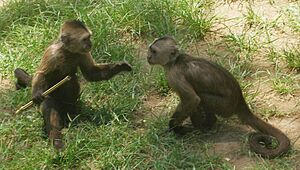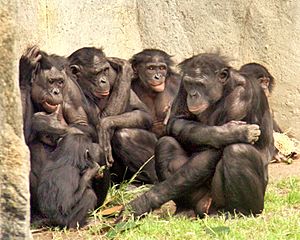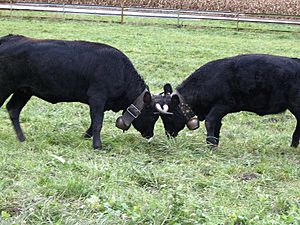Dominance hierarchy facts for kids

In the animal kingdom, many social groups have a special kind of ranking system called a dominance hierarchy. You might have heard it called a pecking order. This system helps to organize the group and decide who gets first access to things like food and safe places to rest.
When animals live together, they often compete for resources. Instead of fighting every single time they meet, they establish ranks. Higher-ranking animals are called dominant, and lower-ranking ones are called subordinate. This social order is created through interactions and can change over time if a lower-ranking animal challenges a dominant one.
This type of social structure is found in many animals, from birds and mammals to insects.
Contents
What is a Dominance Hierarchy?
A dominance hierarchy is like a ladder of power in an animal group. An animal's place on this ladder determines its ability to get resources.
- A dominant animal is one that has first choice of food, resting spots, and partners. Their behavior is not easily influenced by other members of the group. They are often stronger or more experienced.
- A subordinate animal is the opposite. They are lower on the social ladder and often have to wait for their turn. Their behavior is often influenced by the dominant animals, and they are usually submissive, meaning they try to avoid conflict with those ranked higher.

Being at the Top: The Dominant Animal
Being the leader of a group has both good and bad sides. High-ranking animals get many benefits, but they also face challenges.
Benefits of Being Dominant
Getting More Food
One of the biggest advantages for a dominant animal is getting more food. For example, in a group of chacma baboons, the highest-ranking males get to eat first when the group catches prey. In many bird species, dominant birds get the best spots to find food. This means they can eat more quickly and spend less time out in the open where predators might see them.
Raising a Family
Dominant animals usually have a better chance of raising a family. In many primate groups, like bonnet macaques, high-ranking males are more likely to find a partner and have offspring. The children of high-ranking parents often have a better chance of survival because their parents can protect them and provide more resources.
In many bird species that form pairs, the dominant pair gets the best territory to build a nest. A good territory means more food and safety, which helps their chicks grow up healthy.
Costs of Being Dominant
Being at the top isn't always easy. Dominant animals often have higher levels of stress because they constantly have to defend their position. They use a lot of energy protecting their territory, food, and family from challengers.
This constant stress and effort can affect their health. For example, studies on wild baboons have shown that the alpha male has high levels of stress-related chemicals in his body. This can weaken his immune system and make him more likely to get sick. Because of this, dominant animals sometimes don't hold their top rank for very long.
Life as a Subordinate Animal
Being a subordinate animal also has its own set of pros and cons. While they don't get the same perks as the leaders, they have other advantages.
Benefits of Being Subordinate
The main benefit of being a subordinate is safety. By avoiding fights with stronger, dominant animals, they are less likely to get injured. Knowing their place in the pecking order saves both the dominant and subordinate animals from the costs of a long fight.
In some groups, being lower-ranked allows animals to save energy. While the dominant animal is busy defending its status, subordinates can focus on other things. Sometimes, subordinate animals find clever ways to succeed. For example, some young male flat lizards look like females, which allows them to get close to a partner without being noticed by the dominant male.
Costs of Being Subordinate
The biggest disadvantage for subordinate animals is getting less access to resources. They often have to eat last and may not get as much food. They might also be pushed out of the best sleeping spots or shelters.
Subordinate animals also have fewer opportunities to raise a family. In groups of African wild dogs, for example, usually only the alpha female has puppies. This means lower-ranking females rarely get the chance to have their own offspring.
How is Rank Decided?
An animal's rank in a group can be decided in several ways. Sometimes, it involves conflict, but often it is settled without a serious fight.
Many conflicts are more about showing off than actual fighting. Animals might use displays to show their strength. For example, red stags have roaring contests. The stag with the loudest, deepest roar is usually seen as the strongest, and the other will back down.
In other cases, rank is determined by other factors:
- Size and Strength: Bigger and stronger animals often win conflicts and become dominant.
- Age and Experience: In some species, like elephants, the oldest and most experienced female often becomes the leader of the herd.
- Family Ties: In some monkey species, like the rhesus monkey, an individual's rank is based on its mother's rank. The offspring of a high-ranking female will also be high-ranking.
- Plumage or Color: In some birds, like the white-crowned sparrow, the brightness of their feathers can signal their status to others.
Examples in the Animal Kingdom
Birds and the Pecking Order

The term "pecking order" comes from studies of chickens. In 1921, a scientist named Thorleif Schjelderup-Ebbe observed that in any flock of hens, there is a clear hierarchy. One hen is dominant and can peck all the others. The second-ranking hen can peck all but the first, and so on, down to the last hen, who gets pecked by everyone and can't peck anyone back.
This system reduces fighting in the flock because every hen knows its place. Once the order is set, there is more peace in the chicken coop.
Female Dominance in Mammals

In most mammal species, males are dominant over females. However, there are a few interesting exceptions where females are in charge. This is called female-biased dominance.
- Spotted Hyenas: Female hyenas are larger, more muscular, and more aggressive than males. The females are the leaders of the clan, and even the lowest-ranking female is dominant over the highest-ranking male.
- Lemurs: In many lemur species, such as the ring-tailed lemur, females are dominant. They get first choice of food and the best sleeping spots.
- Bonobos: Bonobos are close relatives of chimpanzees. In their society, females form strong bonds and alliances, which allows them to be dominant over the males.
Social Insects: A Queen's Rule
In colonies of social insects like ants, bees, and wasps, there is a very clear dominance hierarchy. The colony is usually ruled by one or a few queens.
The queen is the only one who lays eggs. All the other members of the colony are workers (who are usually her daughters) and are subordinate. The workers spend their lives foraging for food, building the nest, and caring for the queen's young.
The queen maintains her dominant position by producing special chemicals called pheromones. These scents signal her status and prevent the worker females from being able to lay their own eggs. When a queen dies, a new one will take her place, sometimes after a competition between potential new queens.
Not Always a Strict Ladder
Not all animal societies have a strict, linear hierarchy. Some groups are more flexible or even "democratic."
- In chimpanzee groups, the alpha male can't just rule by force. He needs to have friends and allies among the other males to keep his position. He might share food or allow other males to be near him to gain their support.
- In herds of African elephants, the leader is usually the oldest female, called the matriarch. She leads because of her wisdom and experience, not because she is the strongest. The herd follows her because they trust her to find food and water.
- Some animals, like woolly spider monkeys, live in very peaceful, egalitarian groups where there is very little competition and no clear leader.
These examples show that social structures in the animal kingdom are incredibly diverse and can be just as complex as our own.
Images for kids
See also
 In Spanish: Dominancia (etología) para niños
In Spanish: Dominancia (etología) para niños
- Sociobiology
- Sociality



